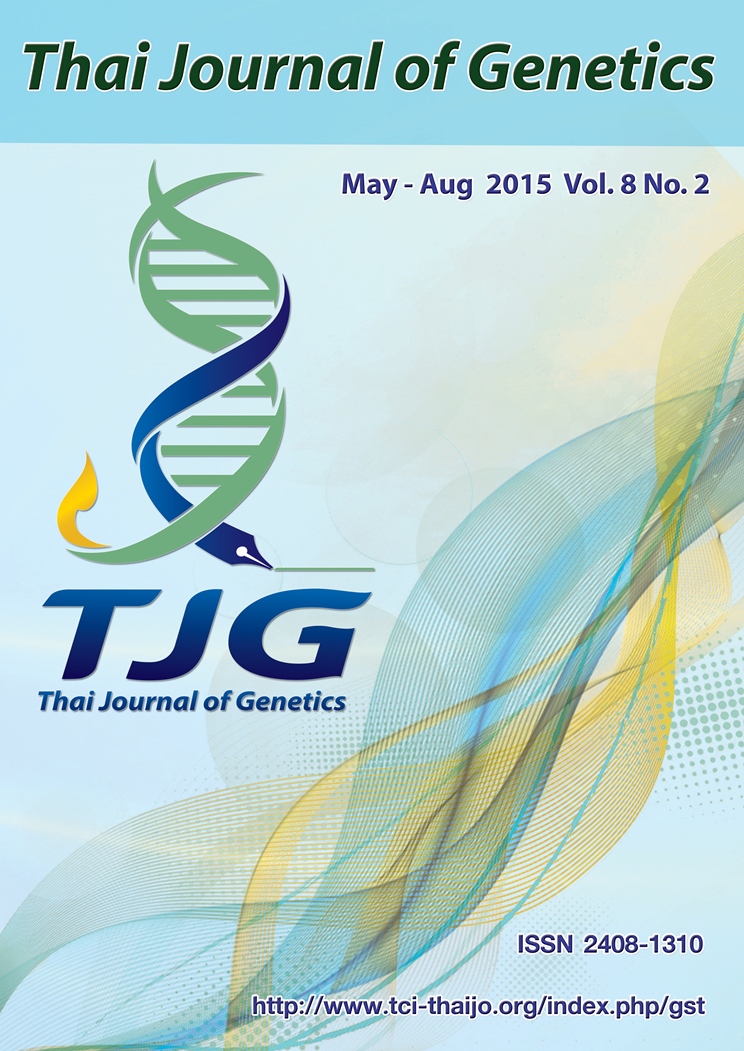Multiplex-STR panels comprehensive for a timely molecular diagnosis of ADPKD
DOI:
https://doi.org/10.14456/tjg.2015.15Keywords:
ADPKD, linkage analysis, short tandem repeat (STR), multiplex, Thai populationAbstract
Autosomal dominant polycystic kidney disease (ADPKD) is the most common inherited renal disease caused by either PKD1 or PKD2 mutations that can lead to fatal end-stage renal disease (ESRD). Direct mutation analysis of ADPKD remains complicated and time consuming. Haplotype-based linkage analysis within-pedigree is a straightforward, alternatively molecular method to diagnose ADPKD, especially in some urgent situations. This study aimed to develop a rapid and efficient short tandem repeat (STR)-haplotype analysis for Thai ADPKD families by investigating in 100 unrelated Thai chromosomes for the informativeness of the 10 and 8 STRs located flanking or within PKD1 and PKD2 genes, respectively. The method was based on multiplex fluorescent polymerase chain reaction (MF-PCR) coupled with detection by laser-induced fluorescent capillary electrophoresis (CE). Two highly informative, multiplex STR panels for rapid, inexpensive and comprehensive molecular diagnosis of both PKD1 (‘PKD1A’: 7 Plex STR) and PKD2 (‘PKD2’: 8 Plex STR) were validated and demonstrated the usefulness in ADPKD families with unknown causative mutations who require timely decision for kidney transplantation from the living-related kidney donors or planning for pre-implantation genetic diagnosis (PGD). This study would be beneficial for differential diagnosis among PKD1, PKD2 or related cystic diseases to timely give a genetic counseling, appropriate management and prognosis to the patients’ families, not only Thais but also Asians and other populations.References
Bae Y, Kim H, Paik M, Lee J, Hwang D, Hwang Y, Ahn C, Kang S (2004) Characterization of microsatellite markers to diagnose ADPKD. Mol Cell Probes 18(3):155–9.
Endreffy E, Maróti Z, Bereczki C, Túri S (2009) Usefulness of combined genetic data in Hungarian families affected by autosomal dominant polycystic kidney disease. Mol Cell Probes 23(1): 39–43.
Harris PC, Rossetti S (2010) Molecular diagnostics for autosomal dominant polycystic kidney disease. Nat Rev Nephrol 6(4):197–206.
Lee JG, Lee KB, Kim UK, Ahn C, Hwang DY, Hwang YH, Eo HS, Lee EJ, Kim YS, Han JS, Kim S, Lee JS (2001) Genetic heterogeneity in Korean families with autosomal-dominant polycystic kidney disease (ADPKD): the first Asian report. Clin Genet 60(2):138–44.
Ott J (1992) Strategies for characterizing highly polymorphic markers in human gene mapping. Am J Hum Genet 51(2):283–90.
Radpour R, Haghighi MM, Ohadi M, Broumand B, Najmabadi H, Hagibeig Ai (2005) Molecular study of PKD1 & PKD2 genes by linkage analysis and determinating the genotype/phenotype correlations in several Iranian families with autosomal domminant polycystic kidney disease. Med J Islam Repub Oflran 19(1): 65–75.
Snarey A, Thomas S, Schneider MC, Pound SE, Barton N, Wright AF, Somlo S, Germino GG, Harris PC, Reeders ST, et al. (1994) Linkage disequilibrium in the region of the autosomal dominant polycystic kidney disease gene (PKD1). Am J Hum Genet 55(2): 365–71.
Thongnoppakhun W, Limwongse C, Vareesangthip K, Sirinavin C, Bunditworapoom D, Rungroj N, Rungroj N, Yenchitsomanus PT (2004) Novel and de novo PKD1 mutations identified by multiple restriction fragment-single strand conformation polymorphism (MRF-SSCP). Bmc Med Genet 5(1):2.
Thongnoppakhun W. (2012) Improved molecular analysis of the genes causing autosomal dominant polycystic kidney disease (ADPKD): an efficient approach using denaturing high performance liquid chromatography (DHPLC) Final research report. Bangkok: The Thailand Research Fund (TRF) 106 p.
Todhunter RJ, Bliss SP, Casella G, Wu R, Lust G, Burton-Wurster NI, Williams AJ, Gilbert RO, Acland GM (2003) Genetic structure of susceptibility traits for hip dysplasia and microsatellite informativeness of an outcrossed canine pedigree. J Hered 94(1): 39–48.
Wang H, Kuwata S, Juji T, Yanagisawa M, Tokunaga K, Horie S, Higashihara E, Kurokawa K, Yoshikura H, Shibata Y (1995) Ethnic differences in allele frequencies of two microsatellite markers closely linked to the locus for polycystic kidney disease 1 (PKD1). Hum Hered 45(2):84–9.
Zeevi DA, Renbaum P, Ron-El R, Eldar-Geva T, Raziel A, Brooks B, Strassburger D, Margalioth EJ, Levy-Lahad E, Altarescu G (2013) Preimplantation genetic diagnosis in genomic regions with duplications and pseudogenes: long-range PCR in the single-cell assay. Hum Mutat 34(5):792–9.
Taiwan Polymorphic Marker Database (TPMD), http://tpmd2.nhri.org.tw/tpmd/php-bin/index_en.php (April 2015)
The NCBI Probe Database (ProbeDB) (http://www.ncbi.nlm.nih.gov/probe/) (January 2013)


